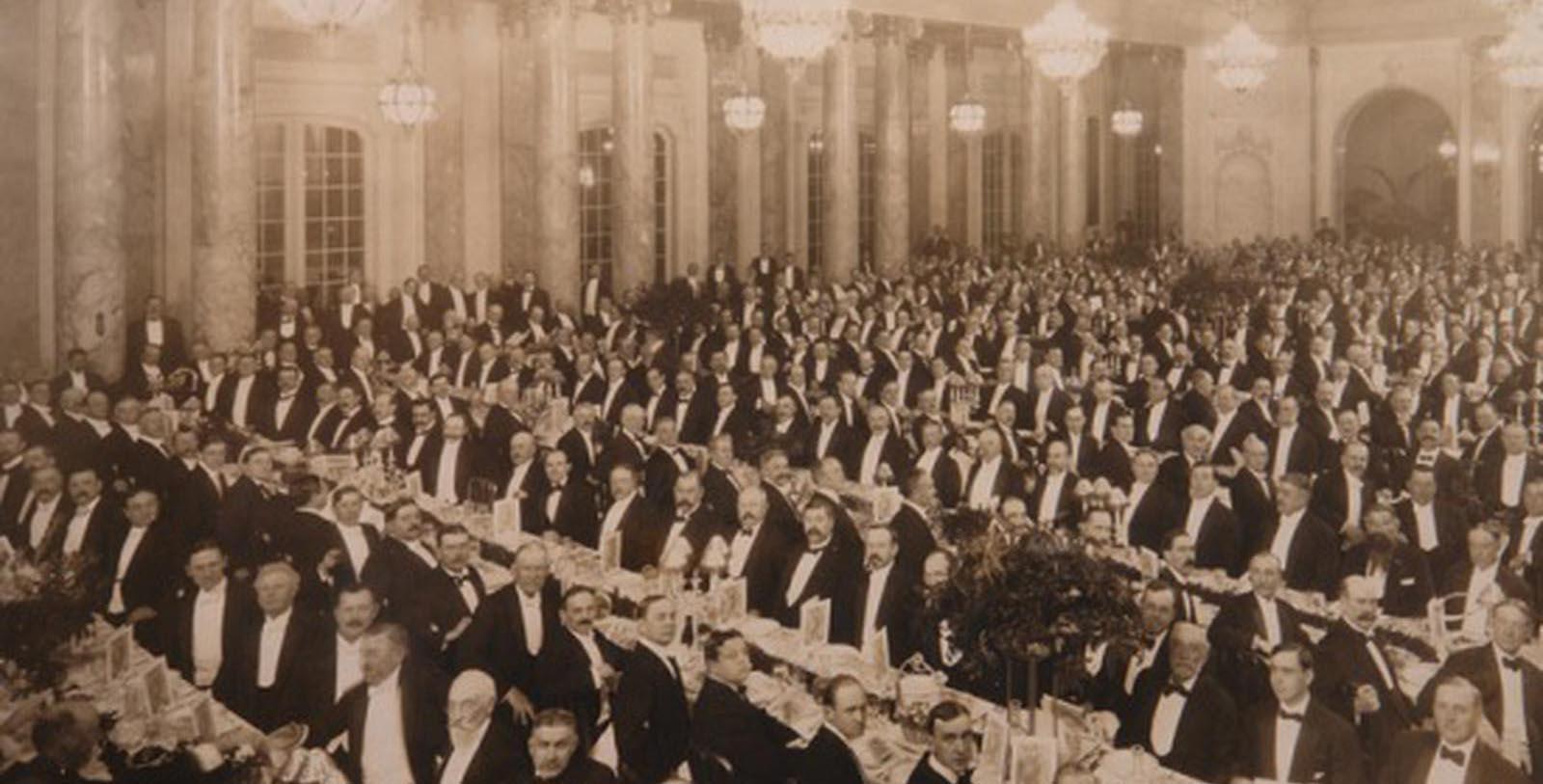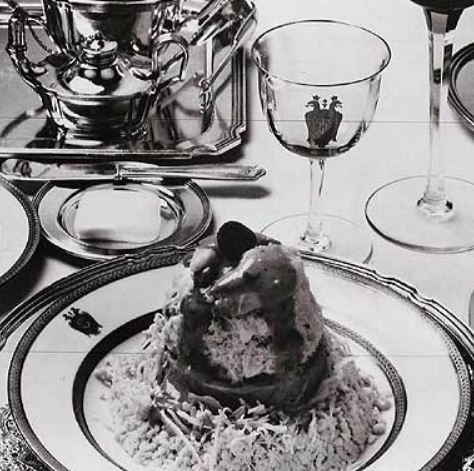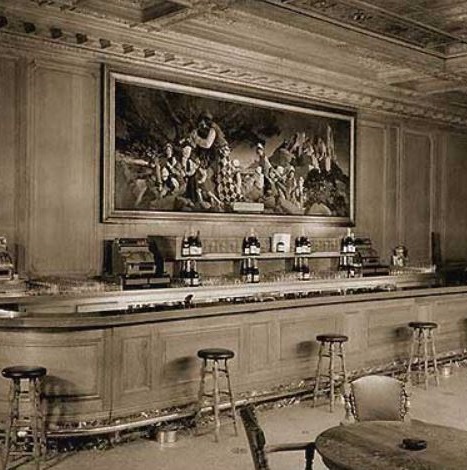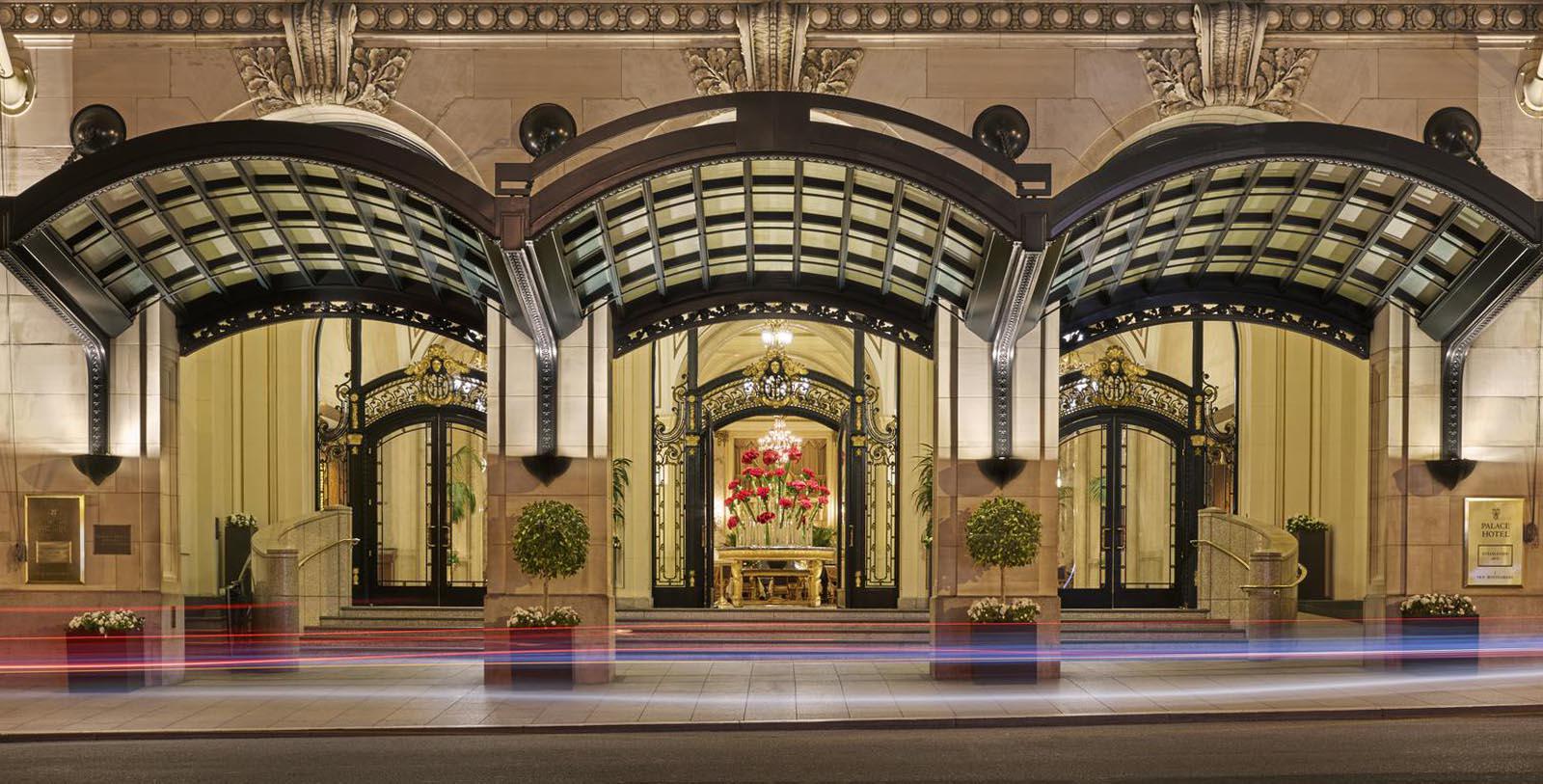Receive for Free - Discover & Explore eNewsletter monthly with advance notice of special offers, packages, and insider savings from 10% - 30% off Best Available Rates at selected hotels.
palace hotel san francisco history
Discover the Palace Hotel with its tradition of excellence and sophistication.
Learn about the Palace Hotel in San Francisco's history. As a member of Historic Hotels of America since 2010, the Palace Hotel in is one of the most renowned destinations active in American today. It is also the most historic in downtown San Francisco, having first debuted before an enthusiastic public at the height of the Gilded Age. The building was the brainchild of William Chapman Ralston, a wealthy financier who had originally co-founded the Bank of California. Using his position within the bank, he invested $5 million of its assets toward developing what he hoped would be the grandest hotel west of the Mississippi River. Ralston subsequently hired John P. Gaynor to craft the appearance of such a building. Using the best resources available, Gaynor designed a towering, seven-story structure that dominated the local skyline. It featured beautiful hues of white and gold, as well as ornate, 14-foot-high ceilings replete with lavish decorations. Each one of its 755 guestrooms contained the best amenities of the day, including an innovative electronic call button that could summon a member of the hotel’s concierge. Perhaps the most stunning aspect Gaynor created was a huge central courtyard known as the “Grand Court.” Topped with a gorgeous skylight, the space extended the full length of the building. Many white double columns lined the expanse of the Grant Court, which was large enough to accept numerous carriages as they dropped off arriving guests. When the Palace Hotel finally opened in 1875, it truly did impress all who stepped inside. Its unprecedented luxury quickly made it an incredibly popular social gathering spot in San Francisco, hosting thousands of people every year. Among the patrons were some of nation’s most influential individuals, including U.S. Presidents like Ulysses S. Grant, William McKinley, and Theodore Roosevelt.
Unfortunately, Ralston never lived to see the success of the Palace Hotel—he died just two months before its debut. Nevertheless, the Palace Hotel continued to thrive until the cataclysmic San Francisco Earthquake of 1906. While the building managed to endure the calamity, it was still in dire need of a comprehensive renovation. Its owners thus initiated an ambitious three-year-long restoration that completely revitalized the historic Palace Hotel. Indeed, the structure possessed countless new facilities upon its anticipated reopening in 1909. Designed by the architectural firm Trowbridge & Livingston, the reborn Palace Hotel featured a wealth of new outstanding architectural details that reflected the reigning concepts of Renaissance Revivalism. Its interior floorplan had many ornate public spaces that added to its reinvigorated palatial character. For instance, the resplendent Garden Court—replacing the Grand Court—contained a wonderful stained-glass ceiling that cost some $7 million to create, as well as a massive series of Ionic columns. Its Pied Piper Bar also amazed with a 16-foot mural painted by Maxfield Parrish that depicted the mythic Pied Piper of Hameilin. These new facilities only further solidified the Palace Hotel’s reputation as one of America’s leading hostelries, and it resumed entertaining many illustrious people over the following decades. In 1919, for instance, President Woodrow Wilson specifically arranged to have a massive dinner party held at the hotel in an attempt to galvanize support for the Versailles Treaty and the League of Nations. Then in 1945, the Palace Hotel played host to dozens of international dignitaries who were ironically in San Francisco to inaugurate the founding of the United Nations.
After operating as part of Sheraton Hotels & Resorts for a time, the Palace Hotel was subsequently sold to a Japanese company known as the Kyo-Ya group during the 1970s. Kyo-Ya Hotels and Resorts oversaw the hotel’s operations throughout the remainder of the century, ultimately shuttering operations for yet another extensive renovation in 1989. The project was massive in scope, as it hoped to authentically preserve every aspect of the Palace Hotel’s rich architectural motifs. Taking years to finish, the entire project ultimately cost a breathtaking $150 million in funding! But the construction was nonetheless worth it, as the building once more teemed with the same vitality that first defined it back in the late 19th century. (Similar renovations transpired in the 21st century, which saw additional work done to the hotel’s historic pool facility, promenade, and iconic Garden Court.) Now managed by Marriott International, the Palace Hotel is still among the best places to stay in all of San Francisco, let alone California. It has received countless awards for its unrivaled hospitality, too, including an Award of Excellence for “Best Historic Hotel (Over 400 Guestrooms)” from Historic Hotels of America. And the preservation of its historical identity has also earned the praise of many professional organizations, such as the American Institute of Architects, the California Heritage Council, and the National Trust for Historic Preservation. Indeed, the City of San Francisco has even designated the building as one of its cherished historical landmarks. No avid cultural heritage traveler should pass on an opportunity to make a trip out to the legendary Palace Hotel.
-
About the Location +
The Palace Hotel resides in the heart of South of Market, one of San Francisco’s most luxurious neighborhoods. It is among the most historic destinations in San Francisco, too, with its first inhabitants arriving at the height of the California Gold Rush in the 1850s. A city of tents sprawled throughout the area, housing thousands of aspiring gold miners lured west under the promise of quick riches. Known as “Happy Valley,” most of the settlement was confined to the only space of dry land in the area, as the locale was predominately untamed marshland at the time. Yet, by the end of the century, the tents had been replaced with a mixture of towering skyscrapers and warehouses. City officials had undertaken the difficult task of dredging most of the surrounding swamp, importing pounds of land just to make the district level. The main avenue through the region was Market Street, which predominantly attracted large amounts of industrial activity. Among the businesses present in the neighborhood included iron foundries, boiler work, machine shops, arms manufacturers, and even breweries. The coastline just a few blocks to the east quickly filled up with wharves, as well, becoming a center for local maritime traffic. But a diverse residential population soon emerged in the region, constituted largely of working-class immigrants from Europe who toiled in the nearby plants. The area around Rincon Hill and South Park also attracted wealthy residents who frequently traveled further into the city for their work. Cable cars operated by the Market Street Railway Company became the most popular method of transportation for the locals, which soon formed an unofficial boundary between the neighborhood and the rest of San Francisco. As such, it developed its own unique identity, eventually becoming known as “South of Market.”
Like the rest of the city, South of Market was completely devastated by the Great San Francisco Earthquake of 1906. In fact, South of Market was among the most devastated areas, as many of the local fault lines resided close nearby. Despite the devastation wrought by the natural disaster, San Franciscans initially rebuilt the neighborhood to integrate it better with the commercial activities elsewhere in town. Over time though, more working-class families moved into the district, specifically single men employed as sailors and seasonal laborers. Thus, the major building projects in South of Market during the first few decades of the 20th century involved residential houses rather than industrial complexes. Furthermore, the shipping industry gradually established itself as the dominant business in the area, replacing the heavy industry that existed in the years prior to the earthquake. Chicanos, Filipinos, and African Americans also started moving into the region, inspired by the plethora of available jobs at the wharves. Urban renewal then spread to the neighborhood shortly after World War II due to the creation of the Embarcadero to the north. It subsequently evolved into an active center for nightlife by the middle of the century, as well as a haven for the local LBGT community. In the 1980s and 1990s, South of Market even developed a reputation for its live music venues, hosting all kinds of performances related to the independent music scene. Today, South of Market is synonymous with downtown San Francisco. It is home to many outstanding cultural attractions, such as Moscone Center, the San Francisco Museum of Modern Art, Oracle Park (home to the historic San Francisco Giants), and the Yerba Buena Gardens. South of Market also contains many iconic skyscrapers in all of San Francisco, including Millennium Tower and One Rincon Hill.
-
About the Architecture +
The beautiful Palace Hotel stands in downtown San Francisco today as a stunning example of Renaissance Revival architecture. Renaissance Revival itself architecture—sometimes referred to as "Neo-Renaissance”—is a group of architecture revival styles that date back to the 19th century. Neither Grecian nor Gothic in their appearance, Renaissance Revival-style architecture drew inspiration from a wide range of structural motifs found throughout Early Modern Western Europe. Architects in France and Italy were the first to embrace the artistic movement, who saw the architectural forms of the European Renaissance as an opportunity to reinvigorate a sense of civic pride throughout their communities. As such, those intellectuals incorporated the colonnades and low-pitched roofs of Renaissance-era buildings with the specific characteristics of Mannerist and Baroque-themed architecture. Perhaps the greatest structural component to a Renaissance Revival-style building involved the installation of a grand staircase in a vein similar to those located at both the Château de Blois and the Château de Chambord in France’s Loire Valley. This particular feature served as a central focal point for the design, often directing guests to a magnificent lobby or exterior courtyard. But the nebulous nature of Renaissance Revival architecture meant that its appearance varied widely across Europe and the Americas. As such, historians today sometimes find it difficult to provide a specific definition for the architectural movement. Regardless, Renaissance Revival architecture today remains one of the world’s most enduring, appearing in countless places across the globe.
-
Famous Historic Events +
Founding of the United Nations (1945): From April to June in 1945, San Francisco hosted a nine-week-long event known as the “United Nations Conference on International Organization.” Attended by delegates from 46 different nations, the conference specifically hoped to create an international organization—the United Nations—that would maintain global peace and cooperation while the world recovered from World War II. The Palace Hotel was just one of seven hotels in the city to entertain the dignitaries from those many disparate countries. Delegations from numerous nations frequented events at the Palace Hotel, too, including a massive dinner regarding the fate of the refuges from the recent Spanish Civil War. Nevertheless, the politicians at the Palace Hotel finally agreed to sign a draft of the United Nations Charter later that summer. The United Nations finally came into existence in October, when the United Nations Charter was formally ratified by all the nations that attended the earlier meetings. (The first to sign the treaty were the organization’s leading nations—China, France, Great Britain, the Soviet Union, and the United States. Known as the “Big Five,” they were the first members of the organization’s now-famous Security Council.) To honor the moment, many of the politicians attended a grand soiree at the Palace Hotel that helped inaugurate the founding of the United Nations. Today, nearly every nation in the world participates in the United Nations, making it one of the most influential organizations in world history.
-
Famous Historic Guests +
Enrico Caruso, renowned Italian operatic tenor.
Oscar Wilde, poet and playwright known for writing such works as The Importance of Being Earnest.
John D. Rockefeller, founder of the Standard Oil Company.
John P. Morgan, legendary financier and founder of J.P. Morgan and Company.
Nikita Khrushchev, First Secretary of the Communist Part of the Soviet Union (1953 – 1964)
Prince Phillip, Duke of Edinburgh
Kalākaua, King of the Hawaiian Islands (1874 – 1891)
Ulysses S. Grant, 18th President of the United States (1869 – 1877)
Benjamin Harrison, 23rd President of the United States (1889 – 1893)
William McKinley, 25th President of the United States (1897 – 1901)
Theodore Roosevelt, 26th President of the United States (1901 – 1909)
William Howard Taft, 27th President of the United States (1909 – 1913) and 10th Chief Justice of the United States (1921 – 1930)
Woodrow Wilson, 28th President of the United States (1913 – 1921)
Warren G. Harding, 29th President of the United States (1921 – 1923)
Franklin Delano Roosevelt, 32nd President of the United States (1933 – 1945)
Bill Clinton, 42nd President of the United States (1993 – 2001)
-
Film, TV and Media Connections +
The Game (1997)







































